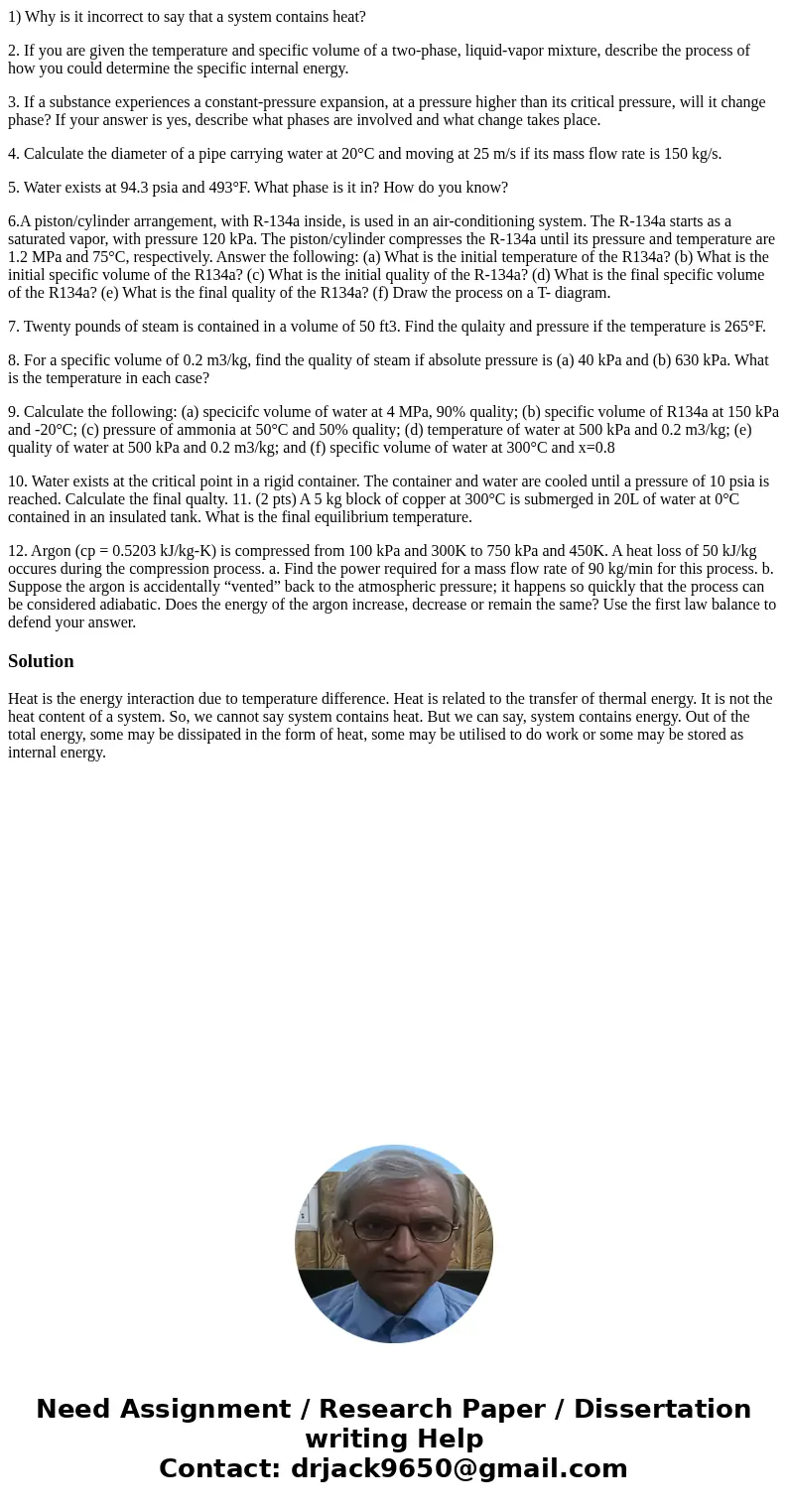1 Why is it incorrect to say that a system contains heat 2 I
1) Why is it incorrect to say that a system contains heat?
2. If you are given the temperature and specific volume of a two-phase, liquid-vapor mixture, describe the process of how you could determine the specific internal energy.
3. If a substance experiences a constant-pressure expansion, at a pressure higher than its critical pressure, will it change phase? If your answer is yes, describe what phases are involved and what change takes place.
4. Calculate the diameter of a pipe carrying water at 20°C and moving at 25 m/s if its mass flow rate is 150 kg/s.
5. Water exists at 94.3 psia and 493°F. What phase is it in? How do you know?
6.A piston/cylinder arrangement, with R-134a inside, is used in an air-conditioning system. The R-134a starts as a saturated vapor, with pressure 120 kPa. The piston/cylinder compresses the R-134a until its pressure and temperature are 1.2 MPa and 75°C, respectively. Answer the following: (a) What is the initial temperature of the R134a? (b) What is the initial specific volume of the R134a? (c) What is the initial quality of the R-134a? (d) What is the final specific volume of the R134a? (e) What is the final quality of the R134a? (f) Draw the process on a T- diagram.
7. Twenty pounds of steam is contained in a volume of 50 ft3. Find the qulaity and pressure if the temperature is 265°F.
8. For a specific volume of 0.2 m3/kg, find the quality of steam if absolute pressure is (a) 40 kPa and (b) 630 kPa. What is the temperature in each case?
9. Calculate the following: (a) specicifc volume of water at 4 MPa, 90% quality; (b) specific volume of R134a at 150 kPa and -20°C; (c) pressure of ammonia at 50°C and 50% quality; (d) temperature of water at 500 kPa and 0.2 m3/kg; (e) quality of water at 500 kPa and 0.2 m3/kg; and (f) specific volume of water at 300°C and x=0.8
10. Water exists at the critical point in a rigid container. The container and water are cooled until a pressure of 10 psia is reached. Calculate the final qualty. 11. (2 pts) A 5 kg block of copper at 300°C is submerged in 20L of water at 0°C contained in an insulated tank. What is the final equilibrium temperature.
12. Argon (cp = 0.5203 kJ/kg-K) is compressed from 100 kPa and 300K to 750 kPa and 450K. A heat loss of 50 kJ/kg occures during the compression process. a. Find the power required for a mass flow rate of 90 kg/min for this process. b. Suppose the argon is accidentally “vented” back to the atmospheric pressure; it happens so quickly that the process can be considered adiabatic. Does the energy of the argon increase, decrease or remain the same? Use the first law balance to defend your answer.
Solution
Heat is the energy interaction due to temperature difference. Heat is related to the transfer of thermal energy. It is not the heat content of a system. So, we cannot say system contains heat. But we can say, system contains energy. Out of the total energy, some may be dissipated in the form of heat, some may be utilised to do work or some may be stored as internal energy.

 Homework Sourse
Homework Sourse